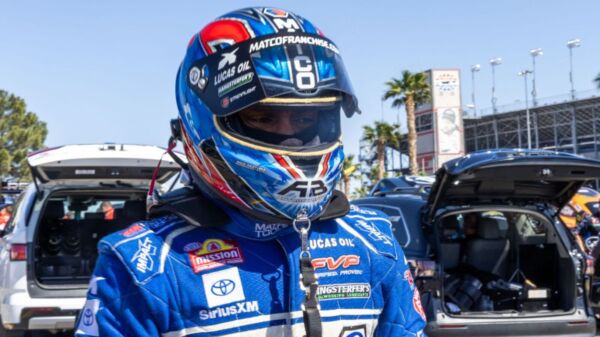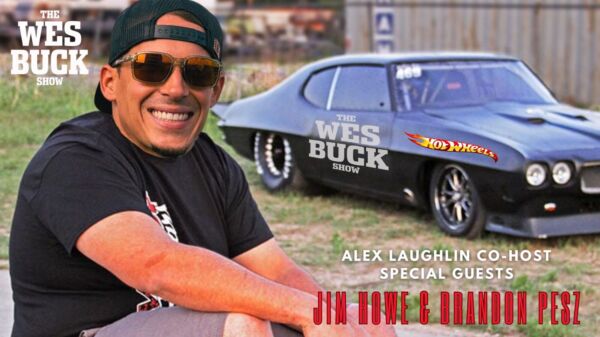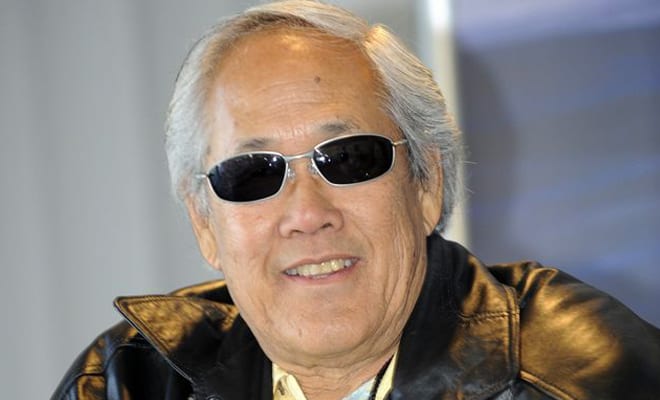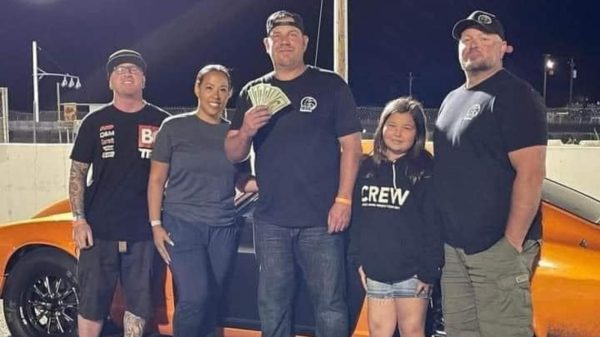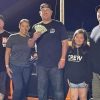He arrived from Honolulu as a teenager, just 17 or 18, he can’t say for certain what year it was, but Roland Leong quickly made his mark on the burgeoning So-Cal drag racing scene. Working alongside and living under the same roof as Dragmaster Chassis co-owner Jim Nelson in Carlsbad, California, Leong quickly learned the trade of welding fast pipe, later moving on to building nitro Hemis under the tutelage of none other than Keith Black himself.
In one of the world’s shortest nitro driving careers–8.01 seconds at 191 mph–Leong ended up on the railroad tracks at the far end of the Lions Beach strip when he couldn’t find the parachute release. The harrowing experience was enough to turn the young Hawaiian, at the insistent urging of Black, strictly into a team owner and tuner. At 20 years old, he never made another high-speed pass down a drag strip.
Instead he paired up with another young California phenom, 23-year-old Don Prudhomme and together in 1965 they won the NHRA Winternationals and U.S. Nationals, with Leong repeating the performance the next season, too, with Mike Snively behind the wheel.
Thus began the life of a professional drag racer for Leong, who eventually switched from Top Fuel to Funny Car because it was easier to book match races for them. His cars, with the “Hawaiian” name prominently spelled out in bamboo-styled letters on their sides, became a standard to strive for in the sport, as Leong became known as a fierce competitor and perfectionist who left nothing to chance, if at all possible.
Leong recently sat down with DRAG ILLUSTRATED to share a few recollections of the old days and update everyone on the Hawaiian’s status on the drag strip.
You being Hawaiian, that’s obviously where the name for your cars came from, but do you remember when you decided to go with that name?
Well, what happened there is the guy that was painting the dragster (in the early 1960s), his name was Joe Anderson—he just passed away not too long ago—anyway, I was in his shop when they were painting the car and he asked me, ‘Well, what are you going to name it?’ I said I don’t know, so he said, ‘Well, you’re from Hawaii; why not call it the Hawaiian?’ So I said okay and that was that.
Being Hawaiian, you probably have a slightly different viewpoint on the world and on the country and on the sport and everything being kind of isolated at least at the start of your life. Was that a benefit to you or was it something you had to overcome when you arrived in California?
For me it was more, how should I put it, coming from Hawaii, just the culture, the people, there’s so many things that are different that when I first came here, I was very intimidated. I felt—not that anybody actually tried to intimidate me—but I felt intimidated. I felt like everybody was staring at me because I looked different. I know I look different. In the early ‘60s there weren’t very many Hawaiian, Asian, Pacific Island, whatever you want to call us, on the mainland. Not like now anyway, so like I say, I felt pretty intimidated. That’s just from where I was born and raised. And then maybe if I came up here in my 20s or 30s it’d be a lot different than coming up here as young as I was.
Prudhomme and I will joke about it to this day. My accent was so bad then that it was a big joke any time we stopped someplace. Prudhomme would tell me, ‘Hey, I’ll do the talking,’ because people just wouldn’t understand me. I wasn’t offended; it was more like it was a joke. It was just different.
When you had all those Hawaiian cars it actually led into some pretty good sponsorship and marketing tie-ins with King’s Hawaiian Bread and Hawaiian Punch and later the Hawaii Tourism Board. How hard did you work at making those deals?
Well, you got to remember one thing. Like a lot of us back then, we weren’t no marketing people; we weren’t no advertising people. You know what I mean? But yet, we did things because it was a matter of survival, not because we knew what to do. If we wanted to keep going, doing this, some of the things we had to do. So you tried to overcome or maybe I’m not doing it any more. That’s how I explained it, anyway.
When did you stop being an active team owner? I know later on you became an NHRA crew chief, but how long did your Hawaiian team last?
What happened was that in 1991 I had been sponsored by Hawaiian Punch for 10 years at the time. And at the time the only longer running major sponsor was Bernstein with Budweiser and I think he had me beat by a year or two. Anyway, Hawaiian Punch was owned by Del Monte Corporation and then in 1990 it was sold to Procter & Gamble. So in 1991 a lot of things changed because the marketing people, they get all changed around and they go and do things like they like, like golf or tennis or whatever. That’s how Prudhomme lost his Miller deal, too, they got bought out.
Anyway, when Procter & Gamble bought out Del Monte, I knew at the end there, they told me I wasn’t going to have a deal after ’91. Well, ’91 was one of my best years of some pretty memorable years. I had Jim White driving for me and we set the national speed record I think four or five times, we won four races, we won Indy, the Big Bud (Shootout), set low ET, and set a new national record there. At the end, we ended up number two in the points and if they had given points for top speed of the race and the top speed for national events, a national record, we would have won the championship, but they didn’t give points for top speed. They still don’t.
Were you seriously concerned that might have been your last season?
Well, yes, so I tried to get something else, of course, which wasn’t easy. I actually didn’t do anything in drag racing in ’92. Then this friend of mine from Hawaii called me and says, ‘Hey, the Center of Tourism said they want to sponsor a Funny Car as a tourism thing, sort of like how at the time, NASCAR had a deal called “Virginia is for Lovers,” that kind of thing.
So I tell him okay, I need X amount of money, what it took to be competitive at the time. And I said, well, first of all, if I didn’t get that much money and if I didn’t get a three-year contract, I ain’t doing it; I’m not even going to fly over there. They said no, no, no, we want to speak with you, so I flew over there and at the time the Center of Tourism wanted it, but it had to go to another department and then finally to the HBB, which is the Hawaii Business Bureau.
But the guy in between (Mufi Hanneman, later the mayor of Honolulu), he said, ‘Yeah, no problem, I’ll give you a check for this much money and a contract from here to here,’ which was up to when the House and Senate goes to session. The session starts in February sometime and goes to about June. So he said after the session is over, we’ll give you the rest of the money for the year and a contract for the next two years for what you want. So I said okay. Well, after the session was over, I tried to call the guy. Guy never called me back. I couldn’t get in touch with him. Well, what it was, this politician at the time that said yes and gave me X amount of money and a contract for this sort of period, he was selected for that job, but had to be voted in by the House and the Senate. Well, he didn’t want the Center of Tourism to come out and lobby against him and he not get the job. That’s why he said okay. But since he got the job, he knew he had the job, he had no intentions of following through.
So I ran in ’93 and the car was called the Hawaiian Vacation car and it was driven by Gordie Bonin. We won a race (Columbus) and if I had ran through to the World Finals we’d have probably been in the top 10 even. But I quit running the car in August, July or August.
So that was the last time you had a Hawaiian car on the track?
Yeah, I sold everything and then I helped this one guy, a friend of mine, his name was Ray Higley. He’s just a regular guy and he didn’t really have that much money and a lot of people wondered why I helped him. Well, the reason I helped him—well, he paid me but he didn’t have that much money—the reason I helped him was because he helped me way back when, when he used to work for Dragmaster when I came over as a kid. And so he had a Funny Car and he asked me to help him, so I did for a little while.
Then Prudhomme hired me to run the Copenhagen car with (Ron) Capps driving; then I ran the Jim Epler car for a little while when he was with Chuck Etchells and so on and so forth. I left the big show about 10 years ago. I’ve been running the nostalgia cars since 2006, I think.
How did you come to be associated with the “Hawaiian” name again?
Well, I ran the Bubble Up car with Ron Hodgson, and then I ran what they call the Troy Lee car with Hodgson and Tim Boychuk and it kind of took me about a year and a half or so to get the car to run because at the time, I hadn’t run nothing like the nostalgia thing.
I quit them in 2013, I guess, because I wanted to buy a part for the car and they didn’t want to do it. So I quit because I told them if I can’t keep making the car go better and win, then I don’t need to be here. I don’t want to go to a race just to go to a race.
So I quit and then the driver, Tim (Boychuk), he called me a year ago, after I was off for about a year and a half I think and hired me back. But all last year, I struggled because a part was bad and I didn’t realize it was bad. Then at the first of this year, I found out the part was bad and I changed it. In the meantime, at the end of the year he asked me if he could put the Hawaiian on the side of the car.
I said yeah, but before I said yes, I asked if his plans were still the same to win an IHRA championship? And he said yeah, so we did it. And the first race this year I found out what was wrong with the car and we went to the semis there. The second race, after I found out what was wrong with the car and changed the part, we won the race. The next race after that, at Bradenton (Florida), we set low ET and were runner-up at that race.
So what happened that you’re no longer working with Boychuk?
Well, after Bradenton he said that he wanted to kind of tune it by committee with Twig Zeigler, himself, and me. Anyway, I said, well, I don’t want to do that because to me, it’s … how should I put it? To me, everybody has to know what makes them tick because not everybody is the same. And you’ll never ever get to really know me at the races because I don’t go around. I’m not there to party. I’m not there to socialize. I’m there to try to win and make the car run the best I can. I guess that’s the way I am. That’s the way I’ll always be and I don’t think I’ll ever change. But anyway, I don’t like to visit. Not that I’m being unsociable, but I can get influenced. And I know that. Well, they say why did you let that happen. Well, I don’t know. It’s just, at times it can influence me and I know the way that I am. So I avoid it. How’s that?
When you try to tune by committee, then you’re not going down a path. Somebody’s always got to compromise. I’ve seen it, been there, done that. And I didn’t want to do it again. So I left the race on a Sunday. Monday, Tim texted me and said that he decided to continue, go forward on his own. He did everything by text, which I don’t agree with. But as it is it’s a good thing because if anybody wants to dispute it, I’ve got it all here, saved in my phone. I didn’t erase it.
Anyway, I don’t want this to come out looking negative for anyone, but when he texted me, I said, well, if I’m not involved I’d like the name taken off the car and he said he’ll take it off at the end of the year. That was the last conversation that we had. So to make a long story short, I had to get a lawyer and trademark my name, which to me is bullshit because I let him put my name on the car not for my benefit. He asked me; I didn’t ask him. I don’t need that.
It’s like Prudhomme says, he says a lot of people, well, anybody that races says they want to win. I guess that’s their mentality, everybody, otherwise why would you even want to do it? But what he says–and I remember this every time I get upset–he says most of them don’t have a clue of how to go about doing that.
Do you still enjoy going racing?
You know, it’s like Prudhomme keeps telling me, he says, why do you want to keep doing this? I said what do you mean? He said, well, getting all stressed out and putting up with all the bullshit. And I said, well, I think it’s because I enjoy doing it. Nobody puts any pressure on me but myself. That’s just the way I am, I guess, because I want to do good. I told him if anybody puts the pressure on me, I quit, because I can quit. No big deal. I can just walk away. But when I do it, I still have sleepless nights and wake up in the middle of the night thinking about this or what would happen if I do that or who do I call or contact to try to, you know what I mean? I guess that’s just my nature. That’s what I’ve done all my life. I don’t know any better. I don’t know any different.
This story was originally published on September 30, 2015. 


